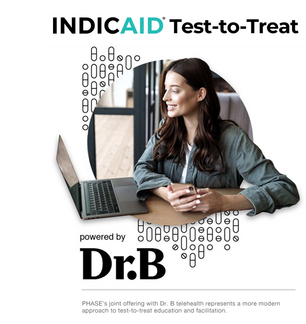The Diagnostic Partner: Expanding The Use of Test-to-Treat in the Post-pandemic World
InsightsFebruary 21, 2023

Test-to-Treat Programs - And Education - Have Been Around Since At Least the 40s.
The federal COVID-19 Test-to-Treat program launched in March 2022 but the test-to-treat response to infectious disease isn’t new. It does need renewal, however.
Test-to-treat describes an early intervention approach to infectious disease in which a patient gets tested as soon as possible and, if positive, promptly receives an appropriate treatment. That’s been acknowledged as sound protocol at least since diagnostic tests for treatable diseases were made available. With the development of penicillin in the 1940s, test-to-treat was instrumental in a dramatic reduction of the incidence of syphilis worldwide in the late 1940s and early 1950s. In the many decades since, it has become a cornerstone strategy across all a variety of ailments. STIs as well as cancer, chronic illnesses, and other infectious diseases like hepatitis are addressed using the same effective strategy. But it was the COVID-19 pandemic that brought the “test-to-treat” nomenclature into the public discourse.

Now, one year after launch, the government’s COVID-19 Test-to-Treat initiative seems to have fallen short of its potential. What can be done to revive it? We spoke with Dr. Jeffrey Klausner of the Keck School of Medicine at the University of Southern California about the challenges around the current COVID-19 test-to-treat strategy. As a medical epidemiologist with decades of experience focusing on public health and infectious diseases, he brought his unique, clear-eyed perspective to the problem.
COVID-19 helped to coin the term test-to-treat for 21st century healthcare consumers. Why was the approach called for?
In the early days of the COVID pandemic there was a lot of regulatory complexity to sort through, so it took time to set up test-and-treat models. But we needed to get better at identifying cases earlier, where we could treat patients for their own clinical benefit while also reducing the likelihood of the forward spread of infections. Once the COVID anti-viral medications came out, it quickly became clear that they were safe and highly effective at reducing hospitalizations. Test-to-treat was especially helpful for people 65 years or older and those who had co-morbid medical conditions. The main motivation and goal of test-to-treat was to flatten the curve of hospitalizations.
How successful has the COVID-19 test-to-treat initiative been?
 There’s still a lot of untapped potential. The implementation has faced all sorts of barriers and limitations. Initially, there was concern about possible drug interactions with Paxlovid, about rebound cases, and there was skepticism about the real benefit of getting early diagnosis and treatment. Then, it was clear that access to test-to-treat providers was a limiting factor. The American Medical Association came out saying that treatment should only be provided by physicians – keeping the prescribing of COVID-19 antiviral medications out of the hands of pharmacists or other clinical professionals.
There’s still a lot of untapped potential. The implementation has faced all sorts of barriers and limitations. Initially, there was concern about possible drug interactions with Paxlovid, about rebound cases, and there was skepticism about the real benefit of getting early diagnosis and treatment. Then, it was clear that access to test-to-treat providers was a limiting factor. The American Medical Association came out saying that treatment should only be provided by physicians – keeping the prescribing of COVID-19 antiviral medications out of the hands of pharmacists or other clinical professionals.
So, the program hasn’t been the type of success it could have been. The medications themselves are 90% effective at preventing hospitalization. With an effective test-and-treat program, far fewer people should have ended up in the hospital. Continued hospitalizations suggest that people are not accessing treatment adequately.
Last year, I led a study of people who tested positive for COVID-19. Among high-risk respondents, 66.0% were aware of treatment for COVID-19, however only 1.7% reported use of an antiviral. It seems that more public outreach is needed to raise awareness of the benefits of treatment.
With a lift in awareness from COVID of “test-to-treat” as a fast, effective response, do you see the approach being rekindled for other infectious diseases?
Yes. STIs are an important area of opportunity for test-to-treat, as is hepatitis C. There’s a big push for what we call point-of-care diagnostics where people can get a test result in less than 30 minutes. I think in the next few years we will see some STI or hepatitis C test-to-treat products, which means that you can get tested by a nurse or medical assistant in a storefront, jail setting, or in a community-based organization. Eventually, we’ll see over-the-counter products combining at home self-tests with treatment coupons or even tests co-packaged with medication.
What advice would you share with healthcare professionals around the test-to-treat approach?
I would encourage them to be raise awareness and promote the program to their patient population. Messages in their patient portals, patient education materials in the waiting room, quarterly wellness newsletters, and website videos. There are many ways to create awareness and educate your patient population.



